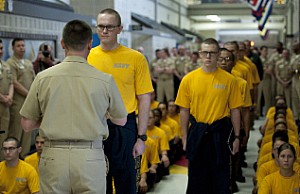Navy.mil Home Page
MCPON Launches eSailor Initiative at RTC
GREAT LAKES (NNS) -- The Navy's top enlisted Sailor, Master Chief Petty Officer of the Navy (MCPON) Mike D. Stevens, was on hand to distribute the first electronic tablets (e-tablets) to the Navy's newest recruits at Recruit Training Command (RTC), April 7.
The launch of the eSailor initiative is a pre-pilot, beta testing to two divisions of 70 recruits to help determine how well the device integrates into the training environment at RTC.
The e-tablet will contain RTC curriculum, including training videos, texts and access to professional development websites.
"As we exploit wireless, mobile technology through the eSailor initiative, I am certain there will be challenges, and we will learn lessons along the way, but we cannot let challenges of security, accessibility, and cost hold us back," said Stevens. "We must embrace these challenges and work through them in order to remain relevant. I do not believe we have an option 'not to' embrace mobile technology if we are going to be relevant in our ability to function in the 21st century and beyond. We must do this and it must start now."
The goal of the e-tablet is to increase the quality of work and quality of life of both recruits and recruit division commanders (RDCs). The e-tablets will use technology already used in elementary through high schools across the nation and incorporate the RTC curriculum, creating a seamless educational transition from civilian to Sailor.
In 2014, Stevens proposed the eSailor initiative to Naval Service Training Command (NSTC), which oversees RTC. Since then, the NSTC-RTC team has worked to develop protocol for the use, care, and programming of the tablets.
"Today is the first step in establishing an effective mobile technology program at RTC," said Rear Adm. Richard A. Brown, commander, NSTC. "RTC and NSTC have partnered together to review training requirements, infrastructure demands, and technological capabilities to realize MCPON Stevens' vision."
The pre-pilot will consist of a six-month study, serving as a rolling start to obtain qualitative data in a cost-effective manner. When a division graduates, the tablets will be collected and redistributed to collect three cycles of data, about 450 recruits in total.
"We are continually looking for ways to improve training at RTC," said Capt. Doug Pfeifle, commanding officer, RTC. "As the Navy's only boot camp, we have an opportunity to impact every Sailor going to the fleet. We are an increasingly technological Navy and our boot camp must not only reflect, but precede the needs of the Navy. As the fleet continually advances in technology, our recruits and staff must embrace this shift as well. Implementing the eSailor initiative will help recruits interface with technology from day one."
Recruits will be instructed on the proper use, regulations and care of their tablets. At the end of each day, tablets will be collected and placed within charging stations where they will be secured until the following day when they will be redistributed.
"I think this is going to help our training because in today's age everyone is so used to having technology right at their hands that we'll be more accustomed to study on a tablet because we're used to it," said Seaman Recruit Karlie Breht, 19.
Currently, recruits receive over 100 hours of classroom and applied training. Much of this curriculum will be included on the tablet for recruits to access and study. For training purposes, the e-tablet for the pre-pilot will include: Navy-owned RTC curriculum, a digital version of the Bluejacket's Manual, and various other training courses.
The tablets will also be used to increase the quality of life of recruits as this technology will facilitate communication with family and friends during time normally allotted to them for letter writing.
"There is no better place to launch eSailor than where we launch every enlisted Sailor in the United States Navy, Recruit Training Command, here in Great Lakes," said Stevens. "Our new Sailors and the professional staff of RTC will leverage this technology for training, while at the same time helping the Navy determine how to proceed into the future, for all Sailors - officer and enlisted."
RTC is primarily responsible for conducting the initial Navy orientation and training of new recruits. The command is commonly referred to as "boot camp" or "recruit training". Boot camp is approximately eight weeks, and all 39,000 enlistees into the United States Navy begin their careers at the command each year. Training includes physical fitness, seamanship, firearms familiarization, firefighting and shipboard damage control, lessons in Navy heritage and core values, teamwork and discipline.
RTC is overseen by Rear Adm. Richard A. Brown, commander, NSTC, headquartered in Building 1; the historic clock tower building on Naval Station Great Lakes. NSTC oversees 98 percent of initial officer and enlisted accessions training for the Navy.
Learn more at http://bootcamp.navy.mil or find us on Facebook at http://www.facebook.com/NavyRecruitTrainingCommand/.
For more information about NSTC, visit http://www.netc.navy.mil/nstc/ or visit the NSTC
For more news from Recruit Training Command, visit www.navy.mil/local/rtc/.
For more news from Naval Service Training Command, visit www.navy.mil/local/greatlakes/.



 To sign up for updates or to access your subscriber preferences, please click on the envelope icon in the page header above or click
To sign up for updates or to access your subscriber preferences, please click on the envelope icon in the page header above or click